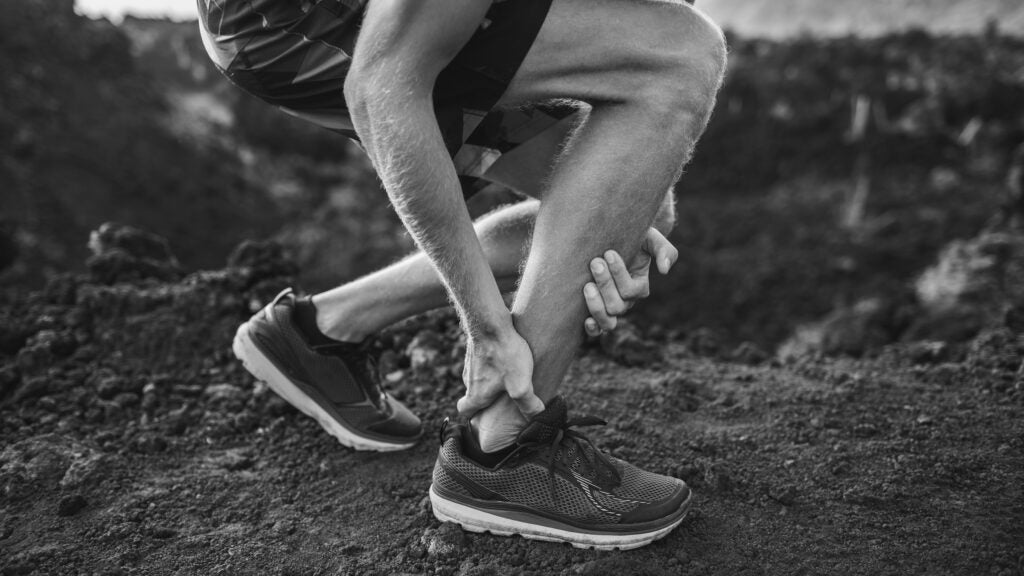No products in the cart.
Outdoor Adventure
How to Beat Achilles Tendinitis
The name Achilles is said to be a combination of two Greek words that together mean “grief of the people.” The injury that bears that hero’s name, in honor of his only weakness, certainly aggrieves many runners, with Achilles tendinitis accounting for around 10 percent of running injuries.
Technically, Achilles tendinitis is acute inflammation of the tendon that runs along the back of the ankle, says Joe Uhan, a physical therapist, coach, and ultrarunner. Pain in that area for longer than a couple of weeks is not really tendinitis anymore. Athletes, however, tend to characterize any pain along the tendon above the back of the heel as Achilles tendinitis.
Achilles tendinitis can be confused with other injuries, such as heel problems, but the hallmark sign is “if you’re pinching the Achilles and it’s really sore,” says Uhan.
Once you have acute pain, says Phinit Phisitkul, a University of Iowa associate professor in orthopedic surgery, the treatment is pretty much the same as with any acute injury—and not something most runners want to hear: rest, ice, anti-inflammatories.
Some doctors also recommend sleeping with a brace on your foot to allow a state of relaxed dorsiflexion and avoid walking around barefoot (or in high heels) so that your tendon isn’t overly shortened or stretched.
Studies have found one of the most successful treatments involves eccentric strengthening exercises, says Phisitkul. Stand on the edge of a step and lower yourself slowly on your injured foot, essentially exerting force as the muscle extends. Then use your other, non-injured, foot to raise yourself back up, so as not to stress the tendon in the rising motion. Do 15 repetitions, twice a day. However, if the pain is severe, it can be best to rest before easing back into exercises and workouts.
Of course, instead of treating the injury when it’s too late, wouldn’t you rather avoid it in the first place? That can be a little complicated, though, since why you get Achilles tendinitis really depends on what you’re doing.
“It’s almost always an overstriding problem,” says Uhan. When your foot lands in front of your trunk, especially if you land on the forefoot, you end up putting all the weight on your Achilles tendon. “That’s stress your body has to absorb.”
While Uhan says that the most common problem he sees is from overstriding, there are other issues that lead to Achilles injuries as well. Runners who don’t engage their glutes tend to push with their toes instead of with their glute muscles, especially when trying to run fast. That kind of stress can cause inflammation.
Basically anything that stresses your Achilles tendon can lead to Achilles tendinitis if you’re not careful: too much mileage, too many hills, too much speed work without building up appropriately. In fact, there isn’t always an obvious reason why someone might start to suffer from Achilles tendinitis. “Most patients usually don’t have any identifiable source,” says Phisitkul.
Fortunately, the Achilles tendon is the strongest tendon in the body. As long as you’re careful while you ramp up your training, you should be able to keep it healthy and strong. Often Achilles tendinitis manifests first as stiffness in the joint that eventually warms up. If, when you first notice the stiffness, you take preventive measures to increase ankle flexibility and pull back on your mileage, speed work, and hill running, then you can avoid it turning into a serious problem.
To prevent Achilles tendinitis in the first place, it’s important to maintain your flexibility. Stretching can help; just don’t overstretch. Simply spend a minute each day stretching your calf and ankle joint. One of the easiest stretches, says Uhan, is to put one foot on the ground behind the other and push into a wall.
In addition to stretching, using a foam roller and getting regular massage to keep the joint mobile can help prevent any problems from starting.
If you start to feel inflammation in your tendon or have Achilles tendinitis once, it isn’t necessarily the end of the world. Let it rest and recover, which can sometimes take as long as four to six weeks if you waited until the pain was acute.
The real problem is if Achilles tendinitis becomes an ongoing injury. If it keeps recurring, then it’s time for the perpetually injured to examine what they’re doing to cause the problem.
“They need to get their running mechanics analyzed by a professional,” says Uhan, who swears that once you get your foot to land all the way underneath you, then the pain goes away quickly.
Source link

